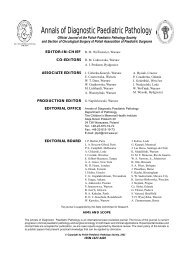annals 1-2.qxd - Centrum Zdrowia Dziecka
annals 1-2.qxd - Centrum Zdrowia Dziecka
annals 1-2.qxd - Centrum Zdrowia Dziecka
Create successful ePaper yourself
Turn your PDF publications into a flip-book with our unique Google optimized e-Paper software.
Annals of Diagnostic Paediatric Pathology 2006, 10(1–2):37–42<br />
© Copyright by Polish Paediatric Pathology Society Annals of<br />
Comparison of histological changes in liver biopsy specimens<br />
in patients with biliary atresia of poor and good prognosis<br />
Joanna Cielecka-Kuszyk 1 , Piotr Czubkowski 2 , Ludmi³a Bacewicz 3 ,<br />
Joanna Paw³owska 2 , Irena Jankowska 2 , Tamara Szymañska-Dêbiñska 1<br />
Diagnostic<br />
Paediatric<br />
Pathology<br />
1<br />
Department of Pathology<br />
2<br />
Department of Gastroenterology, Hepatology and Immunology<br />
3<br />
Department of Pediatric Surgery and Organ Transplantation<br />
The Children’s Memorial Health Institute, Warsaw, Poland<br />
Warsaw, Poland<br />
Abstract<br />
In order to compare intrahepatic histological changes in patients with biliary atresia of poor and good<br />
prognosis, we have examined retrospectively 29 liver biopsy specimens taken during hepatoportoenterostomy<br />
modo Kasai. We divided the material into two groups: 12 biopsy specimens were qualified to<br />
the first – unfavorable group with poor prognosis, because patients died or needed liver transplantation<br />
within 2 years after Kasai procedure and 17 biopsy specimens were qualified to the second – favorable<br />
group with good prognosis, because children have survived over 5 years with native liver. Presence of<br />
prominent giant cell transformation, lobular inflammation and features of ductal plate malformation differed<br />
in these two groups. Lobular cholestasis in zone 2 and 3 was of statistical significance in patients with poor<br />
prognosis.<br />
Key words: biliary atresia, hepatoportoenterostomy, ductal plate malformation, giant cells transformation,<br />
lobular inflammation, cholestasis<br />
Introduction<br />
Biliary atresia (BA) is the commonest cause of infantile cholestasis<br />
and leading indication for liver transplantation in children.<br />
[1]. Progressive fibro-inflammatory changes lead to irreversible<br />
cholangiopathy with complete obliteration of extra<br />
and intrahepatic bile ducts, though basic pathomechnisms of<br />
disease remain unclear. BA could also result from a developmental<br />
aberration occurring between 11 and 13 weeks gestation<br />
[13]. Destructive character of BA leads to death in the<br />
first 2 years of life if untreated [4]. The only chance to limit<br />
disease progression is to establish bile flow by Kasai hepatoportoenterostomy<br />
with best results if procedure is performed<br />
before 8 weeks of age. [11]. Introducing liver transplantation<br />
(LTx) in children opened new era in outcome of BA treatment,<br />
reaching overall 5 year survival in almost 80% of patients.<br />
LTx timing is an important factor influencing outcome<br />
so it is crucial to distinguish early prognostic factors. Characteristic<br />
histopathological changes in liver include cholestasis,<br />
inflammation, fibrosis and ductular proliferation. Prognostic<br />
value of liver histopathology is believed to be crucial but so<br />
far no firm criteria were established [4].<br />
The present study is based on a histological analysis<br />
of the intrahepatic histopathological changes in patients with<br />
poor and good prognosis of the disease. The aim of the study<br />
was to compare the stage of liver fibrosis, inflammation,<br />
ductular proliferation, giant cell transformation and cholestasis<br />
in surgical specimens taken during hepatoportoenterostomy<br />
modo Kasai from patients who had good and poor prognosis.<br />
Address for correspondence<br />
Jaonna Cielecka-Kuszyk Phone: +48 22 815 19 60<br />
Department of Pathology<br />
E-mail: j.kuszyk@czd.pl<br />
The Children’s Memorial Health Institute<br />
Al. Dzieci Polskich 20<br />
04-730 Warsaw, Poland

















